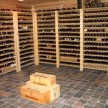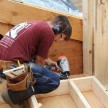Building a Wine Cellar
Building a Wine Cellar in a Basement
I built this wine cellar before I started this website, back then, I did not have a need to take pictures of the framing and preparation process that it took to get to this finished project. Building a wine cellar was a fun and challenging project, read more.
The area chosen for the wine cellar was a corner of the basement that was under an “L” addition. It had three concrete walls – great for temperature consistency. This picture below is the outside of the wine cellar and shows the cooler unit [right of the door]
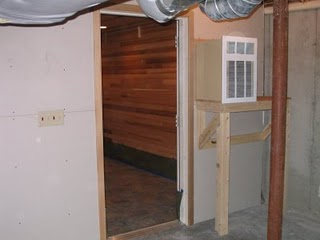 Framing The Wine Cellar
Framing The Wine Cellar
We framed the walls with 2×6 to achieve an R-19 rating for the insulation in the walls and R 30 in the ceiling. Because of the need to maintain the wine cellar’s temperature and humidity, the the 6 mil plastic vapor barrier was applied to the outside of the wall and ceiling framing. [warm side]
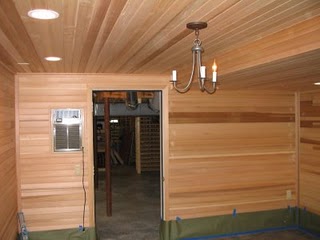 Refrigeration
Refrigeration
The owner choose to purchase a Breezaire refrigeration system. The unit was installed in a side wall and vented into the unfinished basement. The unit maintains cooling and humidity at a constant level.
Temperature and Humidity
When building a wine cellar pay close attention to two considerations with your design of the room:
Temperature
A temperature of 50° F to 55° F and a Relative Humidity of 60% to 70% are ideal for long-term wine storage. A cool temperature slows the aging process, while high humidity helps to swell the cork, which minimizes oxidation. (Oxidation occurs when air reaches the wine.) Ultraviolet light penetration should be kept to a minimum.
An important long-term storage factor. Temperature levels in a wine cellar must be cool and constant. The generally accepted temperature for storing wine is 55°F, although a range of 50° to 60°F is considered acceptable.
Sudden or wide fluctuations in a wine’s temperature will interrupt the proper aging process. Temperature variations not only shrink and swell the cork, but they may also directly affect the organic components in the wine. Gradual fluctuations of up to 10°F between seasons will not likely damage your wine, however, more frequent fluctuations of this magnitude will negatively affect the proper aging process.
Humidity
For long-term wine storage, relative humidity of about 65% at approximately 55°F is ideal, however, a range between 60% and 80% is acceptable. Wine is stored on its side so that the wine is in contact with the cork at all times, keeping the cork wet we incorporated the owner’s existing wine racks into the planning of the room dimensions. The room’s interior dimension accommodates the racks perfectly.
Lower humidity levels will dry the air-side of the cork, allowing for air leakage or capillary pull action of the wine toward the dry side. This allows oxygen to come in contact with the wine, causing immediate aging. High humidity levels will not harm the wine.
Wall and Ceiling Finish
We chose tongue and groove cedar for the walls and ceiling. Wine cellars have high humidity and cedar is an excellent insect and rot-resistant material and looks great.
We installed vertical “corner boards” in the corners to separate the two mating walls. This avoids the uneven horizontal lines that eventually would occur.
View of the cellar before the wine racks were installed. the built section of the ceiling is concealing HVAC duct work.
Corner boards – walls and ceiling junction.
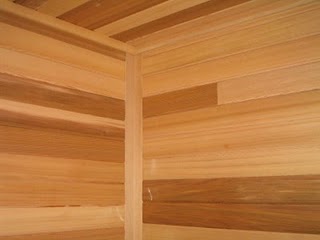 Flooring:
Flooring:
We installed a 6″ x 6″ slate tile on the concrete floor. The green paper was to protect the un-finished cedar walls.
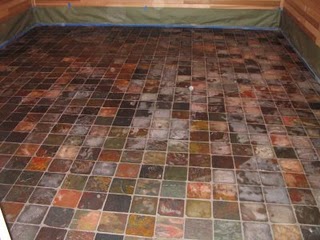
Lighting:
Sealed recessed lights were installed on both sides and spaced out to illuminate the fronts of the wine racks. The chandelier was installed for aesthetics. Both on dimmers.
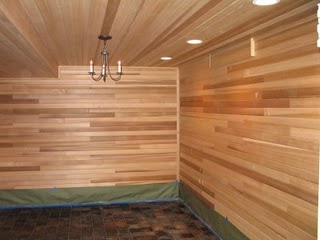
Wine Racks:
Pre owned wine racks were installed in the room and the wine moved into it’s new home. [center view]
Left view. Finished floor.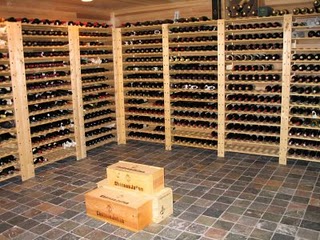
Left view.
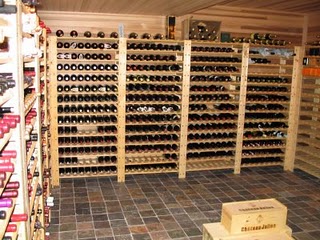 Entry Door:
Entry Door:
Right view and an entry door. The steel-insulated, exterior-rated door was already on site and was re-used.
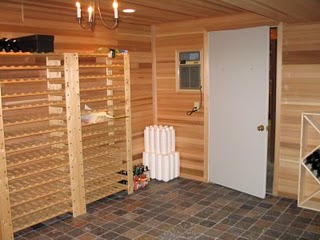 Customization:
Customization:
This sign was taken from an actual wine box the owner had. The name Churchill happens to be the owner’s name. I took the box and made a sign out of poplar trim. I stained the poplar to match the sign and installed it on the wine cellar’s door as a surprise.
The owner loved it!
View through the door.
Left wall, entry wall. The room temperature at this time was 55 degrees. Man does that Cedar smell great.




